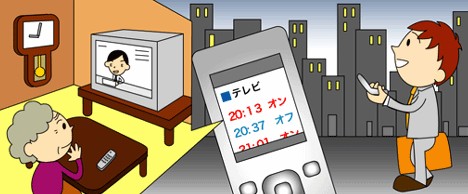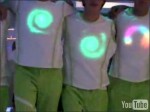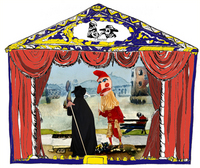Jul 24, 2007
Second Life Running on Nokia n800

Second Life resident Wrestling Hulka has a limited version of the virtual world running on the Nokia n800.
another mobile client for Second Life was developed by Comverse earlier in the year
21:25 Posted in Virtual worlds, Wearable & mobile | Permalink | Comments (0) | Tags: virtual worlds
Jul 23, 2007
iPhone progenitor?
19:20 Posted in Wearable & mobile | Permalink | Comments (0) | Tags: i-phone
Jul 17, 2007
Global mobile phone use to hit record 3.25 billion
Global mobile phone use to hit record 3.25 billion ( i.e. half world population )
00:27 Posted in Wearable & mobile | Permalink | Comments (0) | Tags: mobile phones
Jul 06, 2007
Mobile Games in 2007, 49.9% Growth
From Mobile Games Blog
Gartner has let loose new speculations on the mobile games market. Next to their expectations for 2011, they announced a 49.9% market growth in 2007 alone!
The growth in 2007 will lead the mobile gaming market to a value of about $ 4.3 billion. With this growth in mind, they calculated an even bigger increase all the way up to $ 9.6 billion by 2011 (non-consumer billed downloads are of course not calculated).
A big part of the mobile market share will belong to the Asian territory where the value for this year is expected at $ 1.8 billion and a growth of 255.55% will be established until $ 4.6 billion in 2011.
Compared to Asia, Western Europe will not see much growth. With a value of $ 1.5 billion currently, Gartner expects the growth to be only 133.33% which translates to a value of $ 2 billion. In response to the interview, 10% of the consumers claim to have played or downloaded a mobile game in the past month. The biggest part of them (4 out of 5) obtain their games through the operator deck.
Read the full post
15:53 Posted in Wearable & mobile | Permalink | Comments (0)
Jun 14, 2007
Special Issue on Wireless Technologies, Mobile Practices
The Canadian Journal of Communication invites submissions, in English or in French, for a forthcoming special issue on mobile communications and wireless technologies. We are interested in innovative, critical approaches that decipher a range of mobile technologies and practices in wireless contexts. Possible themes include:
- Everyday uses: sharing our lives via the mobile (text, voice, video)
- Civic engagement, activism and mobile technologies
- Wireless services and emergency communication
- Privacy, surveillance and mobile phones
- Community Wireless Networks
- Policy: CRTC regulations and spectrum policy
- Mobility, Labour: new conditions of work
- Shifting notions of space, place and time in a mobile world
- Rhetoric and discourses on mobility and wireless worlds
- Art, design and mobile technologies
- Mobile genres and cellular convergence
- Global and international perspectives on mobile technologies
Full-length papers (@ 7000-9000 words) should be submitted electronically following the guidelines laid out on the CJC submissions website.
15:45 Posted in Call for papers, Wearable & mobile | Permalink | Comments (0) | Tags: wearable
May 02, 2007
Psychnology: special issue on Mobile Media and Communication
The special issue of Psychnology Journal on "Mobile Media and Communication: Reconfiguring Human Experience and Social Practices?" is online
Contents (click on the links to download the full paper)
Editorial Preface
Ilkka Arminen
Is It Fun to Go to Sydney? Common-Sense Knowledge of Social Structures and WAP
Ilpo Koskinen
Texters and Talkers: Phone Call Aversion among Mobile Phone Users
Ruth Rettie
Discourses on Mobility and Technological Mediation: The Texture of Ubiquitous Interaction
Giuseppina Pellegrino
Mobile Fantasies on Film: Gathering Metaphoric Evidence of Mobile Symbiosis and the Mobile Imaginary
Kathleen M. Cumiskey
23:00 Posted in Wearable & mobile | Permalink | Comments (0) | Tags: mobile
Apr 27, 2007
Cellphone-operated remote control home system
From Pink Tentacle

NTT-Neomeit, an NTT subisidiary, has unveiled plans for a convenient and inexpensive service that allows users to remotely control home devices from their cellphones.
Read full post on Pink Tentacle
12:40 Posted in Wearable & mobile | Permalink | Comments (0) | Tags: telepresence
Apr 24, 2007
Special Issue on Mobile Learning and Knowledge Management: Issues in Intellectual Proximity
Enterprises have turned to explicit - and even conceptualising on tacit - knowledge management to elaborate a systematic approach to develop and sustain the intellectual capital needed to succeed, the knowledge normally attributed to knowledge workers. This is complemented by structural capital, i.e. the structures, technologies, practices put in place by an organisation as an attempt to manage their specialist knowledge. Mobile learning would equally come under such an umbrella, enticing knowledge workers and managers within organisations to conduct work in a mobile manner.
One of the challenges for future mobile organisations will deal with how they can enhance communication channels and collaborate within and between their employees, customers and stakeholders. According to Liebowitz (Liebowitz, 2006), one technique that can help address this issue is social network analysis. Mobile organisations also need to develop new knowledge and learning strategies possibly under the umbrella of a knowledge exchange or sharing system, and especially as related to recognition and reward systems. Uden (Uden, 2006) suggests that activity theory, as a social and cultural psychological theory, can be used to design a mobile learning environment.
Existing theoretical work has paid limited attention to the role of intellectual proximity in facilitating knowledge exchange within clusters of organisations that operate within the same domain of knowledge.
A consensus suggests that users build a mental model from their interactions with artificial systems. Design of mobile devices needs tp to take into consideration the existence of a gap between the user’s viewpoint [interaction-oriented] and the designer’s viewpoint [development-oriented]. Enhancing mobile learning effectiveness requires narrowing this gap between execution and conception. Implementing new solutions for improving the effective use of mobile systems needs new methodological tools and a better understanding of the complexity of user’s mental construction, in line with their containment of the domain knowledge.
The purpose of this special issue is to expose writers and the eventual readership to topics aiming at the facilitation of mobile learning for knowledge workers, from differing and multidisciplinary perspectives.
- Knowledge management and mobile learning
- Knowledge flow and mobile learning
- Dissemination of practice and mobile learning
- Currently implemented applications for mobile learning
- Technologies that directly support mobile learning systems (devices, networks, tools etc.)
- Studies of mobile learning in practice
- Reviews of the application of mobile learning in multiple contexts
- Uses of mobile learning in professional learning environments, e.g., mobile health, mobile commerce
- Constraints in the delivery of mobile learning, e.g., human-computer interaction issues in mobile learning environments
- Mobile games for learning
- The role of Wikis, blogs, podcasts, messaging, other on-line tools and Web 2.0 components in mobile learning systems and as mechanisms to exchange/distribute knowledge
- Support for learner interaction and mobile collaborative learning
- Privacy and security issues in mobile learning
- Knowledge expropriation or hoarding issues in mobile learning
- The role of location based services in learning and sharing knowledge
- Organisational structures and mobile learning
- Management issues from mobile learning
- Design of user-friendly mobile devices
- Mental models emerging from interactions with mobile systems
- User's characteristics (age, gender, culture, expertise, etc.) and mobile learning
- Graphic user interface (GUI) design and mobile learning
- Mobile learning interactions and cognitive modeling
Submitted papers should not have been previously published nor be currently under consideration for publication elsewhere. All papers are refereed through a peer review process. A guide for authors, sample copies and other relevant information for submitting papers are available on the Author Guidelines page
14:36 Posted in Call for papers, Wearable & mobile | Permalink | Comments (0)
Mar 16, 2007
Snout Performance & Public Forum
From Urban Tapestries
__________________________________________________
Venue: Cargo, 83 Rivington St, Kingsland Viaduct, London, EC2A 3AY
The performance will start at Cargo and the route will include Hoxton
Square and Hoxton Market
Dates/Times: Tuesday 10 April, Performance 10am, Conference 1.30-5pm.
Tube: Old St, Liverpool St
Admission: Free
Access: Limited, please call in advance for details
Information: +44 (0)20 7729 9616, www.iniva.org, institute@iniva.org
Supported by Arts Council England & Esmée Fairbairn
Download the eFlyer
__________________________________________________
With increasing concerns about climate change, individuals and communities are looking for new ways to take action and make a real and lasting impact.
In the Snout 'carnival' performance and public forum, artists, producers, performers and computer programmers demonstrate how to create wearable technologies from scavenged media, in order to map the invisible gases that affect our everyday environment. The project by inIVA, Proboscis and researchers from Birkbeck College also explores how communities can use this visual evidence to participate in or initiate local action.
The performance will show in action two prototype Snout sensor 'wearables' based on traditional carnival costumes. Carnival is a time of suspension of the normal activities of everyday life - a time when the fool becomes king for a day, when social hierarchies are inverted, a time when everyone is equal. Snout proposes 'participatory sensing' as a lively addition to the popular artform of carnival costume design, engaging the community in an investigation of its own environment, something usually done by local authorities and state agencies.
A public forum on 'participatory sensing and media scavenging' will be held after the performance. This will demonstrate the Snout wearables, discuss evidence collecting for environmental action and how communities can reflect on the personal impact of pollution and the environment. The forum, led by Giles Lane (Proboscis) and Dr George Roussos (Birkbeck) will look at 'participatory sensing' as a form of social engagement. The forum will share tactics on how to 'scavenge' free online services and resources, as well as exploring the relationship between information, aesthetics and design and how to make these ideas and issues accessible to more people.
Snout is a new collaboration between inIVA, Proboscis and researchers from Birkbeck College exploring relationships between the body, community and the environment. It builds on a previous collaboration Feral Robots (with Natalie Jeremijenko) to investigate how data can be collected from environmental sensors as part of popular social and cultural activities.
22:22 Posted in Wearable & mobile | Permalink | Comments (0) | Tags: wearable
Methods of Understanding and Designing For Mobile Communities


 have a look at this PhD thesis by Jeff Axup - lot of interesting stuff about mobile research methods...
have a look at this PhD thesis by Jeff Axup - lot of interesting stuff about mobile research methods...
Download the entire thesis here:
Methods of Understanding and Designing For Mobile Communities
Major research outcomes presented in this thesis lie in three areas: 1) methods, 2) technology designs, and 3) backpacker culture. Five studies of backpacker behaviour and requirements form the core of the research. The methods used are in-situ and exploratory, and apply both novel and existing techniques to the domain of backpackers and mobile groups.
Methods demonstrated in this research include: field trips for exploring mobile group behaviour and device usage, a social pairing exercise to explore social networks, contextual postcards to gain distributed feedback, and blog analysis which provides post-hoc diary data. Theoretical contributions include: observations on method triangulation, a taxonomy of mobility research, method templates to assist method usage, and identification of key categories leading to mobile group requirements. Design related outcomes include: 57 mobile tourism product ideas, a format for conveying product concepts, and a design for a wearable device to assist mobile researchers.
Our understanding of backpacker culture has also improved as a consequence of the research. It has also generated user requirements to aid mobile development, methods of visualising mobile groups and communities, and a listing of relevant design tensions. Additionally, the research has added to our understanding of how new technologies such as blogs, SMS and iPods are being used by backpackers and how mobile groups naturally communicate.
22:15 Posted in Wearable & mobile | Permalink | Comments (0) | Tags: mobile, wearable
Mar 15, 2007
Augmented reality on cell phones
From Technology Review
Nokia wants to superimpose digital information on the real world using a smart cell phone.
A prototype uses a GPS sensor, a compass, and accelerometers. Using data from these sensors, the phone can calculate the location of just about any object its camera is aimed at:
Last October, a team led by Markus Kähäri unveiled a prototype of the system at the International Symposium on Mixed and Augmented Reality. The team added a GPS sensor, a compass, and accelerometers to a Nokia smart phone. Using data from these sensors, the phone can calculate the location of just about any object its camera is aimed at. Each time the phone changes location, it retrieves the names and geographical coördinates of nearby landmarks from an external database. The user can then download additional information about a chosen location from the Web--say, the names of businesses in the Empire State Building, the cost of visiting the building's observatories, or hours and menus for its five eateries.
00:28 Posted in Augmented/mixed reality, Wearable & mobile | Permalink | Comments (0) | Tags: virtual reality
Feb 24, 2007
Light-emitting shirts
check out ths cool wearable display developed by Philips researchers. They are integrating LEDs into fabrics to obtain light-emitting clothes


15:34 Posted in Wearable & mobile | Permalink | Comments (0) | Tags: wearable
Feb 01, 2007
Google: the future is in mobile phones
From Textually.org




[via Mad4MobilePhones] "It is clear that 2007 will be the year that mobile search query traffic grows substantially. Our current model is to use targeted text ads and we have evidence that the monetization of those ads is higher than in non-mobile uses. So it looks like the advertising revenue on a per-search query is likely to be significantly higher on mobile than on non-mobile.
As part of that, we are investing in new categories of using mobile devices. For example, YouTube content is being used and can be viewed on mobile devices in various partnerships that we're doing. Those are as much opportunistic for us, and they're not really driving revenue yet; although in theory, you could imagine a combination of video, video advertising on a mobile phone that would have the best entertainment value but also very, very high monetization rates. We're unlikely to split it out. It's not material today in a financial sense, and more importantly, it's still emerging.
We are making a significant investment in technology around mobile because of the growth rate of mobile and the ultimate scale of that business. You won't really see its financial impact until `08."
22:58 Posted in Wearable & mobile | Permalink | Comments (0) | Tags: mobile, wearable
Jan 31, 2007
BuddyCheckService helps seniors
Re-blogged from Textually.org
BuddyCheckService helps seniors that live alone keep their independence. It uses ASR speech technology to enable overtaxed family caregivers to monitor loved ones on a regular basis, and are alerted by text message or call on their mobile phone if there is an emergency.
17:15 Posted in Wearable & mobile | Permalink | Comments (0) | Tags: mobile, wearable
New mobile monitoring system from Loughborough University
Via Medgadget



Researchers at Department of Electronic and Electrical Engineering at the Loughborough University in the UK are planning to introduce a portable telemedicine technology to the market. The system enables a doctor to observe remotely up to four different medical signals from a freely moving patient. Signals that can be transmitted include the ECG, blood pressure, oxygen saturation and blood glucose level.
Now Professor Woodward has been awarded a grant by the UK-India Education and Research Initiative (UKIERI), enabling him to join forces with experts in India on the project. Working with the Indian Insitute of Technology Delhi (IIT Delhi), the All India Institute of Medical Sciences, Aligarh Muslim University and London's Kingston University, he is hoping to miniaturise the system, designing 'smart' sensors and mini-processors that are small enough to be carried by patients and able to acquire biomedical data from them. The network of sensors will be linked via a modem to mobile networks and the internet, and to a hospital computer. The device would then be used by doctors to remotely monitor patients suffering from chronic diseases, such as heart disease and diabetes, which affect millions of people across the world.
"Such a 'Mobile Disease Management System' is long overdue," says Professor Woodward. "Especially in view of the proliferation of applications in mobile data communications. It is also achievable in a three-year time frame and should provide a step-change in improving the quality of life of patients needing expert diagnoses, and for those with pre-diagnosed conditions or undergoing post-operative care.
"In the UK, the project will allow a more patient-driven health service, as promoted by the Government to improve the efficiency of health care delivery. In India, the project will link clinics and regional hospitals in remote areas to centres of excellence. As in the UK, the Indian Government is encouraging the integration of new and existing networks, much needed because of a large population spread over a vast area.
Link at Loughborough University...
00:56 Posted in Wearable & mobile | Permalink | Comments (0) | Tags: mobile, wearable
Jan 27, 2007
GPS Sneakers Send SMS to Parents if kids go off limites
From Textually.org

GTX GPS Xplorer Smart Sneakers keep track of your kids and if they wander beyond a delimited area, a GPS signal activates a text message alert to the parents phone.
13:15 Posted in Wearable & mobile | Permalink | Comments (0) | Tags: mobile, wearable
Jan 25, 2007
Second Life gets virtual mobile operator
From Textually.org

Vodafone is planning to launch itself as a mobile operator in the game Second Life alongside its Vodafone Island area within the popular virtual world, reports TechDigest
"Second Life users will be able to use branded handsets to call each other within the world, as well as send text messages."
Second Life Cell Phones can SMS real world Phones
22:06 Posted in Virtual worlds, Wearable & mobile | Permalink | Comments (0) | Tags: virtual reality, second life
Jan 15, 2007
The Luke Johnson Phone Experiment
From Textually.org
The Cell Freak reports on a cell phone experiment by 27 year-old Luke Johnson from Arizona, solliciting calls to his cellphone through a video published on YouTube."The idea is to find out how many people will call me if I post my cell phone on the Internet for the whole world to see. Call my cell phone. I don't care why you call or what you say. .. Meanwhile, I'm going to keep track of how many calls I receive to find out how many strangers will call someone they've never met before in their entire life."So far 11,914 people have taken Luke Johnson up on his offer, some from as far away as Japan, Thailand, and South Africa and and his social project has been picked up by CNN.
23:50 Posted in Wearable & mobile | Permalink | Comments (0) | Tags: social networks, mobile phones
Jan 10, 2007
Finger Touching Wearable Mobile Device
Re-blogged from Textually.org (via Yanko Design)

A wearable mobile device for enhanced chatting, by Designer Sunman Kwo.
"A new wearable device that anyone can communicate with that is easier and lighter in mobile circumstances corresponding to the 3.5G, 4G communication standard. Human hand is the most basic communication method.
For easier and simpler controls, it uses the instinctive input method "finger joint". Excluding the thumb, each finger joint makes up twelve buttons, with "the knuckle button", using the cell phone's 3X4 keypad, likely being the most popular input method."
22:21 Posted in Future interfaces, Wearable & mobile | Permalink | Comments (0) | Tags: mobile phones
iPhon
22:15 Posted in Wearable & mobile | Permalink | Comments (0) | Tags: mobile phones











